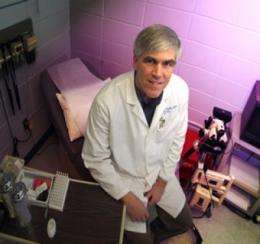Dr. Daron G. Ferris at Georgia Health Sciences University is leading a National Cancer Institute-funded study to determine whether a polarized filter can help reduce unnecessary cervical biopsies and surgeries. Credit: Phil Jones, GHSU Photographer
The same filtered light that enables sunglasses to reduce glare may improve a physician's ability to detect early signs of cervical cancer, reducing unnecessary biopsies and surgery.
Polarized light is more focused than traditional radial light which scatters in all directions, said Dr. Daron G. Ferris, colposcopist, family medicine physician and Director of the Gynecologic Cancer Prevention Center at Georgia Health Sciences University.
When a woman gets an abnormal Pap smear, it's often followed by a colposcopic exam where radial light and magnification are used to view the cervix then biopsies are performed on suspicious areas.
A National Cancer Institute-funded study is helping determine whether also taking a look through a polarized filter improves the ability to detect precancerous changes, enhancing efficacy while reducing needless biopsies and the discomfort and cost that may result.
"Using both types of light to examine the cervix may give us additional perspective so we can find more disease and avoid treating something that does not need it," Ferris said.
In the study of 300 women age 18 and older, Ferris is first using the standard approach, including marking suspicious areas, then taking another look with the polarized filter to see how the findings correlate before doing a biopsy. "If we use polarized light, how does that change what we can see?" he said.
The approach might be most effective in young women where normal immature cell types in the cervix are more difficult to discriminate from neoplastic cells. This extremely thin skin is an easy target for infection by human papillomavirus, the primary cause of cervical cancer, Ferris said.
"If polarized light eliminates cases where it's not clear whether the area is worrisome or not, that is going to reduce the number of biopsies," Ferris said. "We want to see if it adds value." And the confusion may not end with the biopsy: sometimes biopsies also are misinterpreted, leading to unnecessary surgery.
Just as polarized glasses help fisherman see fish swimming below the water surface, polarized light, which focuses its energy in one direction, also enables physicians to better see beneath the surface of the cervix for telltale signs of trouble. In suspicious areas, blood vessels tend to be more dilated, farther apart and more randomly distributed. "We normally look at superficial blood vessels, but this takes us to a level we have not been able to see," said Ferris of the ability to see 1 millimeter (.04 inches) below the surface with the polarized filter.
Ferris got the idea that polarized light might enhance colposcopy from studying hundreds of images of the cervix taken for fluorescent spectroscopy, which uses a polarized filter to reduce the reflection created by fluorescent light. "I started seeing things that I had never seen before and it struck me that it might be of use in colposcopy," said Ferris, who was part of a study trying to teach computers to recognize cervical lesions.
Dermatologists have been using polarized filters for years to look at external skin surfaces. Some colposcopy machines, where the cervix is viewed through a monitor rather than a microscope, already are equipped with a polarized light filter to reduce glare. Most colposcopes now have green filters that block red light so blood vessels appear black and are easier to detect.
Studies have questioned colposcopy's accuracy. Two National Cancer Institute researchers concluded in a 2006 article in the American Journal of Obstetrics and Gynecology that colposcopy was missing cancerous lesions and efforts to improve accuracy were needed.
The bagel-shaped cervix is the door to the uterus, which produces mucus and helps keep a fetus in the womb during pregnancy. Biopsies of the thin-skinned organ can result in bleeding and increase infection risk.
Journal information: American Journal of Obstetrics and Gynecology
Provided by Georgia Health Sciences University






















